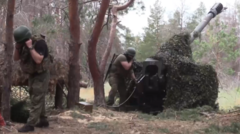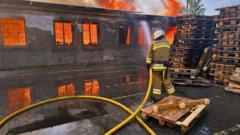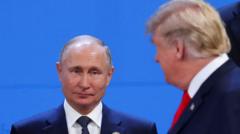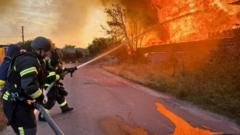As Russian drone and missile attacks intensify against Ukraine, the military claims to have made substantial territorial gains across a wider front. However, a combination of fierce Ukrainian resistance and logistical challenges continues to impede their progress.
Russia Intensifies Multi-Front Assault in Ukraine Amidst Staunch Resistance

Russia Intensifies Multi-Front Assault in Ukraine Amidst Staunch Resistance
Russia's military ramping up efforts across three fronts in Ukraine, despite facing significant opposition.
Russia's military operations in Ukraine have reportedly escalated to unprecedented levels over recent weeks, including an overnight surge in drone and missile strikes. Armed forces have claimed significant territorial gains, seizing around 556 square kilometers—marking their largest acquisition this year, per data from the DeepState monitoring resource. This territory is equivalent to an area four times the size of Liverpool or nearly the entire city of Chicago.
Moscow aims to disrupt supply lines used by Ukrainian forces in the eastern regions, creating a buffer zone to secure its northern borders. Despite the evident intensity of these operations, the slow pace of advancement implies that at this rate, it could take more than 70 years for Russia to gain full control of Ukraine.
The military push centers around three critical areas: the Sumy region bordering Russia, the strategic hubs of Pokrovsk and Kostyantynivka, and a newly opened front west of Pokrovsk. In the Sumy region, Russian troops have made some progress, advancing 10 to 12 kilometers, yet have met robust resistance, stalling further incursions.
Russian President Vladimir Putin is keen on establishing a buffer to safeguard Russian territory following Ukrainian advances into Kursk territory last summer. However, without significant reinforcements, Russian advances seem unlikely to proceed effectively, especially given the fierce defense mounted by Ukrainian forces.
Reports indicate that Ukrainian troops are diligently defending Pokrovsk, a key location that has remained a target for more than two years, highlighting the presence of around 111,000 Russian troops in that region. Infantry has been the dominant mode of attack recently, with Ukrainian military officials indicating that larger troop movements are countered vigorously by drone surveillance, with a focus on small groups attacking persistently.
In eastern Ukraine, the situation remains dire for both sides, as Ukrainian forces are under increasing pressure from Russian attempts to encircle them between Pokrovsk and Kostyantynivka. While some gains have been reported in Russian operations, Ukrainian officials firmly dispute these claims, insisting they continue to hold strategic advantage.
As logistical challenges rise on the front lines, delivering supplies to troops has become increasingly perilous. Ukrainian soldiers report that previously safe routes have now turned into high-risk zones vulnerable to drone attacks, severely complicating their operations. This is exacerbated by the new capabilities of Russian drones, designed not only for tactical strikes but also for inflicting psychological damage on civilians.
Military analysts suggest that Russia’s ongoing operations may heavily rely on political gains rather than strategic advantages, especially in areas like Dnipropetrovsk, where reports of advancement have not been verified by Ukrainian officials.
As the situation unfolds, the effectiveness of ongoing Russian operations remains uncertain, and both sides brace for continued conflict amid the war-torn landscape of Ukraine.
Moscow aims to disrupt supply lines used by Ukrainian forces in the eastern regions, creating a buffer zone to secure its northern borders. Despite the evident intensity of these operations, the slow pace of advancement implies that at this rate, it could take more than 70 years for Russia to gain full control of Ukraine.
The military push centers around three critical areas: the Sumy region bordering Russia, the strategic hubs of Pokrovsk and Kostyantynivka, and a newly opened front west of Pokrovsk. In the Sumy region, Russian troops have made some progress, advancing 10 to 12 kilometers, yet have met robust resistance, stalling further incursions.
Russian President Vladimir Putin is keen on establishing a buffer to safeguard Russian territory following Ukrainian advances into Kursk territory last summer. However, without significant reinforcements, Russian advances seem unlikely to proceed effectively, especially given the fierce defense mounted by Ukrainian forces.
Reports indicate that Ukrainian troops are diligently defending Pokrovsk, a key location that has remained a target for more than two years, highlighting the presence of around 111,000 Russian troops in that region. Infantry has been the dominant mode of attack recently, with Ukrainian military officials indicating that larger troop movements are countered vigorously by drone surveillance, with a focus on small groups attacking persistently.
In eastern Ukraine, the situation remains dire for both sides, as Ukrainian forces are under increasing pressure from Russian attempts to encircle them between Pokrovsk and Kostyantynivka. While some gains have been reported in Russian operations, Ukrainian officials firmly dispute these claims, insisting they continue to hold strategic advantage.
As logistical challenges rise on the front lines, delivering supplies to troops has become increasingly perilous. Ukrainian soldiers report that previously safe routes have now turned into high-risk zones vulnerable to drone attacks, severely complicating their operations. This is exacerbated by the new capabilities of Russian drones, designed not only for tactical strikes but also for inflicting psychological damage on civilians.
Military analysts suggest that Russia’s ongoing operations may heavily rely on political gains rather than strategic advantages, especially in areas like Dnipropetrovsk, where reports of advancement have not been verified by Ukrainian officials.
As the situation unfolds, the effectiveness of ongoing Russian operations remains uncertain, and both sides brace for continued conflict amid the war-torn landscape of Ukraine.






















